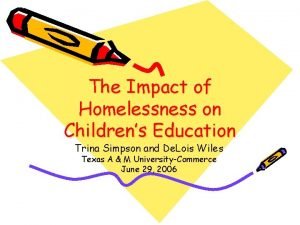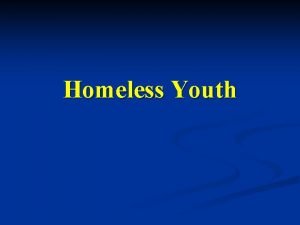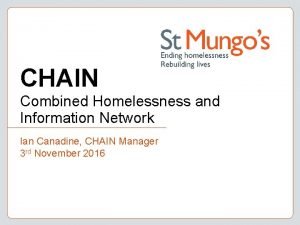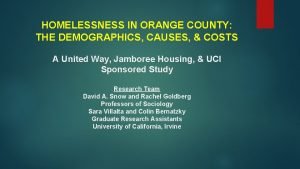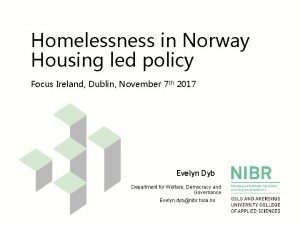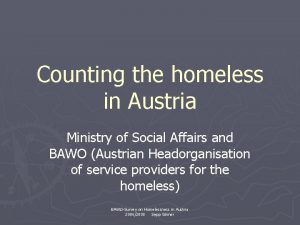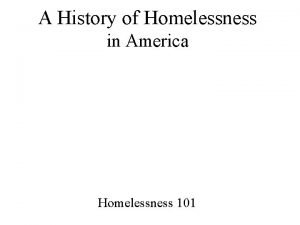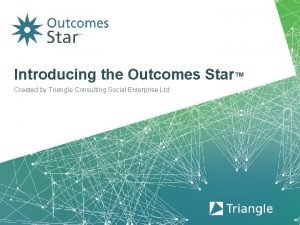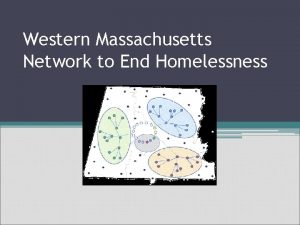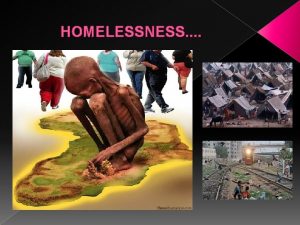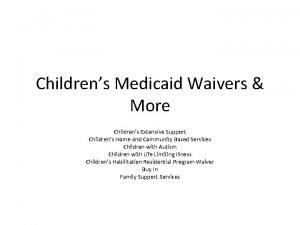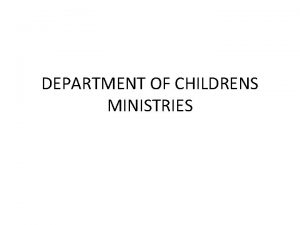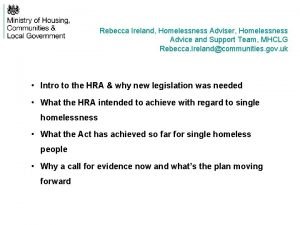The Impact of Homelessness on Childrens Education Trina















- Slides: 15

The Impact of Homelessness on Children’s Education Trina Simpson and De. Lois Wiles Texas A & M University-Commerce June 29, 2006

Fact: The request for emergency shelters increased by 17 percent between 1999 and 2000. It was estimated that 27 percent of those request were unmet (Duffield, 2001). The purpose of this study is to examine the effects of homelessness on children’s education. There is a need to identify ways to provide supports that will help these children achieve academic success. The differences were in ethnicity, native language, and school location. Data collected from research noted in several journal articles was used to identify interventions. It is our conclusion that there are interventions that will enable students to be successful in school.

Focus Finding ways to meet the needs of homeless children has been a major challenge for teachers. Studies have shown that when students and their families are connected to counseling/community services they tend to perform better in school.

Fact: It is estimated that more than 1 million youth are homeless on any given night. Of these more than 750, 000 are of school age (Collignon & Nunez, 1997). • • Homelessness has many faces

The Definition of Homeless The federal governments legal definition of homelessness based on the Mc. Kinney-Vento Homeless Education Assistance Act is anyone who…. • Lacks a regular, fixed and adequate nighttime residence (substandard housing) • Is sharing housing due to economic struggles ( double-up) • Is living in a shelter, hotel or motel • Is living in a public place not designed for sleeping (cars, parks) • Is an unaccompanied youth • Is a child or youth awaiting foster care placement • Is a child or youth abandoned in a hospital • Is a migrant who qualifies under any of the above

Literature review Our three primary sources of information were the following journals: Nabors, L. ; Sumajin, S. ; Zins, J. ; Rofey, D. & Berberich, D. (2003). Evaluation of an Intervention for Children Experiencing Forum Homelessness. Child & Youth Care. Markos, P. A. , & Lima, N. R. (2003). Homelessness in the united States and It’s Effect on children. Guidance and Counseling. Noll, E. & Watkins, R. (2003). The Impact of Homelessness on Children’s Literacy Experiences. The Reading Teacher. .

Fact: In 1998, 13. 9 million people---40 percent of all poor people--- had income of less than half the poverty level (Bureau of the Census, 1999). Research Questions How does access to counseling services to families of homeless children affect student’s achievement, attendance, and selfesteem? What impact does failure to follow guidelines of the Mc. Kinney. Vento Act have on public school funding and the provision of educational services? How does social skills development, teacher interaction, and peer tutoring affect the academic achievement of homeless children ?

Fact: Less than 16 percent of eligible pre-school aged homeless children are enrolled in preschool programs ( U. S. Department of Education, 2004). Variables: • Creation of a system of checks and balances which monitor educational services to homeless children. • Increased accessibility to school/ community counseling services. • Identification of a contact person within the school district who could positively impact services to homeless children. • Increased efforts on the part of teachers and student’s peers to offer additional support.

Interventions to increase a child’s self-concept at school may provide an important building block for their later development and psychological well-being (Markos & Lima, 2003). Interventions: • Grants that provide funding of salaries for shelter tutorial staff, computers, and other educational supports. • Using counselors as a resource for connecting with community services that improve the family/students quality of life. • Local Education Agency use of funding form the Mc. Kinney. Vento Act to ensure that assistance with school enrollment, transportation, school supplies, and coordination among local service providers is available. • Teacher, volunteer, and peer-based tutoring.

Fact: A study conducted in New York City, found that 23 percent of homeless children repeated a grade, and were placed in special education classes, many times inappropriately ( Institute for Children and Poverty, 2003) Target Audience • Homeless children who are old enough to receive educational services (Pre-K, K, 1 -12) • Families of homeless children

Fact: Every state has a coordinator for the education of homeless children and youth. Documentation of observations conducted at a local homeless shelter. Prior to participation in this studies, permission was obtained from Albuquerque New Mexico School System and Children’s parents. Information was also obtained from databases. (see References)

Fact: School is one of the few stable, secure places in the lives of homeless children and youth ( National Coalition for the Homeless ). Data Collection • Research professional journals/databases for statistical information on homeless children

Fact: Although African Americans are disproportionately represented among the homeless, homelessness affects all socioeconomic classes, ethnicities, cultures, and races but is clearly linked to poverty (Dail, 2000; Nunez & Fox, ) Data Analysis Statistics on homeless children in the United States • 52 percent are age five or younger • 36 percent are between the ages of six and twelve years old • 12 percent are between the ages of thirteen and sixteen years old

Fact: Congress reauthorized the Mc. Kinney. Vento Homeless Education Act in 2002 and incorporated it into No Child Left Behind ( U. S. Department of Education). Conclusion Supports are key to enhancing educational growth for homeless children.

Fact: Teachers who conduct research on better ways of serving homeless children help them to build brighter futures (Trina & De. Lois, 2006).
 Jeopardy
Jeopardy Trina simpson
Trina simpson Finland homelessness solution
Finland homelessness solution Homelessness
Homelessness Youth homelessness definition
Youth homelessness definition Chain homelessness
Chain homelessness Michigan campaign to end homelessness
Michigan campaign to end homelessness Abolish homelessness
Abolish homelessness Causes of homelessness orange county
Causes of homelessness orange county Homelessness in norway
Homelessness in norway Homelessness in austria
Homelessness in austria Timeline of homelessness in america
Timeline of homelessness in america Typology
Typology The bill homelessness was
The bill homelessness was Outcome star
Outcome star Western mass network to end homelessness
Western mass network to end homelessness

